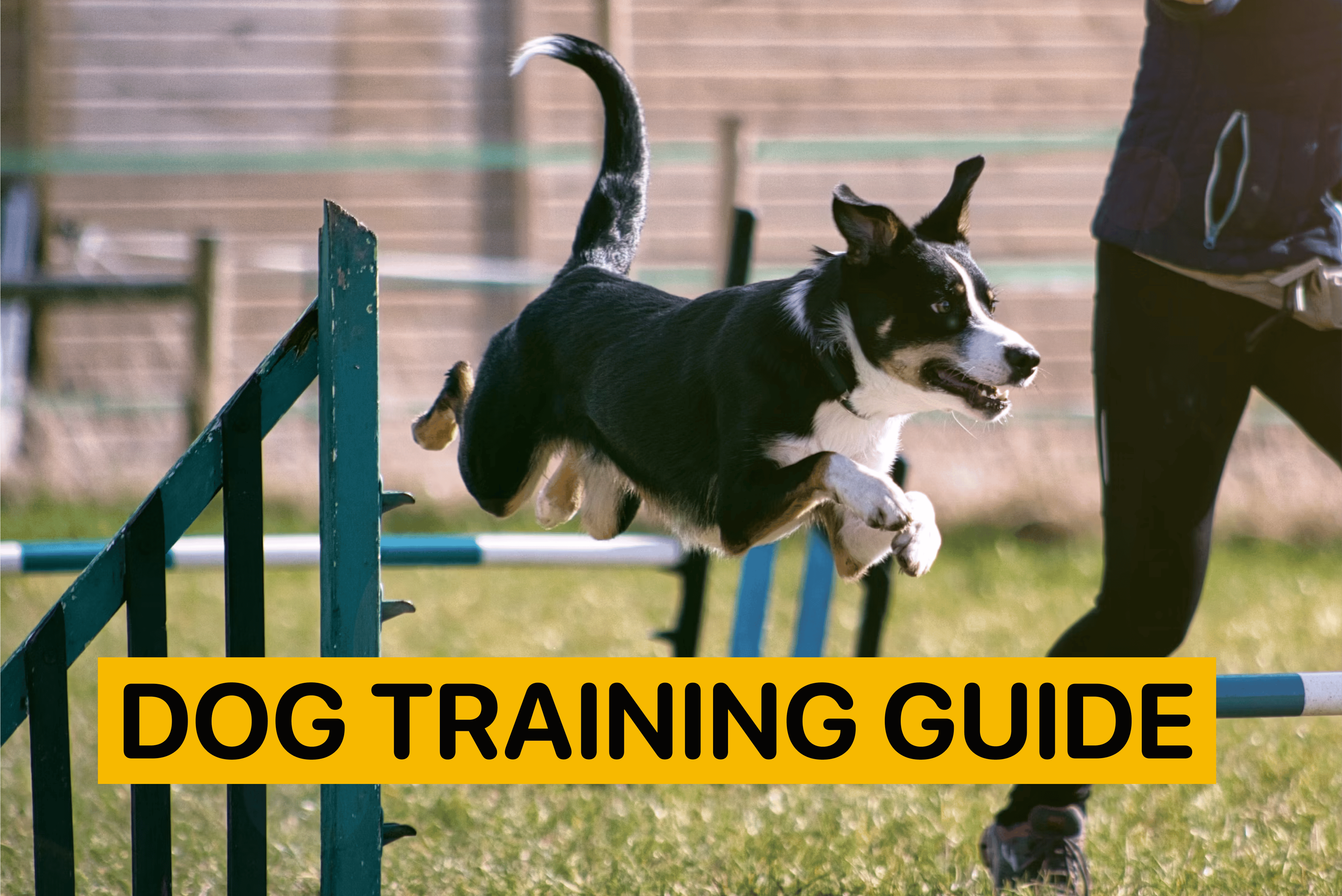15 Easy and Advanced Tricks to Teach Your Dog

By
Woofz Team Updated on |Reviewed by Shannon Kenny
Key Takeaways
-
Teaching your dog tricks is a great way to strengthen your bond and provide mental stimulation
-
Use positive reinforcement methods, and opt for short training sessions
-
Some tricks are easier to teach if your dog already knows a few basic commands
-
Before practicing certain dog tricks, consult a vet to ensure these activities don’t pose a risk to your pet’s health.

How to Teach Your Dog Tricks
Teaching your pooch new tricks brings multiple advantages for both you and your furry companion. It can help strengthen your bond, reinforce basic obedience commands, and add fun to your daily interactions. Follow these steps to ensure that trick training is fun and easy for you and your dog.
-
Choose your time wisely: Plan training sessions carefully, avoiding practice when your dog is too tired or hungry, as they won’t be able to focus.
-
Keep your sessions short: It’s better to arrange several short training sessions throughout the day than to practice for an hour at a time.
-
Try memory games: Play games like hide-and-seek to boost your pet’s cognitive abilities and provide mental stimulation.
-
Reward and reinforce: Use positive reinforcement methods to foster a positive attitude toward training.
10 Easy Tricks to Teach Your Dog
1. Spin
The spin command is a popular and easy trick to teach your dog. Your dog spins completely in a circle, either to the right or the left. This trick is a great starting point for dog training and can be taught to dogs of all ages and sizes. When starting, don’t forget to grab a high-value treat to get your dog's attention.
Benefits: Besides being fun, the spin command has practical benefits. It helps dogs focus on their handler, improves their body coordination, and lays the groundwork for advanced agility training and heelwork. It’s also a great stretching exercise and can be used to keep your dog engaged while walking on a loose leash.
2. Play dead
The play dead command is a fun trick that teaches dogs to lie on their side and stay still. It usually involves the words “bang” or “pow,” along with a finger-gun gesture. This trick is a good way to start using lure-based training methods and helps dogs stay mentally engaged while strengthening the bond between dog and handler.

The verbal cue “Play dead” is helpful for all dogs because it enhances communication and fosters a stronger training bond. It can be especially beneficial for high-energy breeds, as it works on impulse control (staying still) and building duration in a stationary position. To learn this trick, dogs need to show body awareness and focus – skills they can use in other training situations.
3. Fetch specific items
Fetch is a game where you throw an object for the dog to chase and bring back. For some dogs, this might be their favorite activity in the world!

Benefits: Fetch is an excellent outlet for energy, helping dogs maintain physical fitness and mental sharpness. It also deepens your relationship through bonding and trust-building during play.
4. Open and close doors
The open-and-close-doors command teaches dogs to use doors by pushing, pulling, or touching them. This skill is often part of service dog training but can also be taught to pet dogs to help with household tasks and demonstrate advanced obedience.

Dogs can learn to close doors behind them for privacy, open doors for family members who have trouble moving, or simply act as a fun party trick. Training in this skill provides great mental exercise and demonstrates how well dogs can solve problems.
This verbal cue is especially helpful for families with elderly members or people with disabilities, as well as in situations where hands-free door operation is needed.
5. Stay
The stay command tells dogs to remain in their current spot, whether sitting, lying down, or standing, until given a release cue. Unlike “wait,” which means to pause briefly and expect movement afterward, "stay" requires them to hold that position until the handler returns. Dogs may adjust their lying or sitting position, but they must not leave the designated spot.

Benefits: The stay command is important for safety in many situations. It prevents dogs from rushing through open doors, helps them remain still during veterinary exams, and keeps them safe around traffic. Training dogs to stay also strengthens impulse control, which can reduce jumping and begging.
6. Sit pretty
The “sit pretty” command, often called “beg,” involves your dog sitting up on their hind legs with their front paws lifted in front. It's an adorable trick that never fails to impress people!
Benefits: Learning “sit pretty” builds core and back strength, boosts confidence, and prepares dogs for more advanced tricks. Teaching this trick is fun for both dogs and their owners.
Note: This trick is best for healthy dogs. If your pup has had any injuries in the past, it’s a good idea to check with your vet before starting.
7. Speak
The “speak” command teaches your dog to bark on cue. This command enhances communication and can be useful in situations such as search and rescue or alerting owners to unusual events.
Benefits: Teaching this command provides mental stimulation and strengthens the bond between you and your pet. It also helps dogs improve impulse control, especially when paired with the "quiet" command. Additionally, it can boost the confidence of shy dogs by allowing them to bark in a controlled way.
8. Back up
To put it simply, the “back up” command tells your dog to move just a few steps away from you.
Benefits: This command teaches your pup body awareness, helping prevent problems like blocking doorways or rushing past people. It’s also a great way to ask your dog to move without physically having to move them!
9. Wave
The wave command teaches your pup to lift their paw and wave in the air. This trick is charming and easy for most dogs to learn (if they already know “paw” or “shake paws.”)
Benefits: It helps improve coordination, communication, and paw skills. It also strengthens the bond between you and your furry friend.
10. Middle
With the “middle” command, you can tell your pup to sit between your legs, facing forward or backward.

Benefits: This command helps build confidence and is practical if you often find yourself in busy or distracting environments with your pup. It also helps anxious or reactive dogs stay safe and focused in crowds.
5 Advanced Tricks to Teach Your Dog
1. Crawl
The “crawl” command teaches dogs to move forward while keeping their bodies low to the ground.
Benefits: Crawling helps strengthen your dog's core and keeps their mind engaged. It’s a useful trick for training self-control and improving body coordination. Crawling is also effective for therapy and obedience training.
2. Leap
This trick trains dogs to jump over or onto objects when asked. It enhances athleticism and coordination while creating an impressive “wow” factor.

Benefits: Leaping builds muscles, improves coordination, and boosts confidence. It also provides an energetic way for active dogs to train.
3. Balance a treat on a nose
The name of the command speaks for itself. This trick teaches dogs to balance a treat on their nose. Canines learn to hold the treat until given a release cue to flip or catch it. It’s often a favorite for demonstrating a pup’s skills.
Benefits: This trick teaches impulse control and builds trust between you and your dog. It also promotes patience, self-control, and focus.
4. Cover your eyes
In this trick, dogs learn to use their paws to cover their eyes on cue. It creates a cute and expressive behavior and is entertaining, while also demonstrating your dog’s ability to respond to cues in a playful way.
Benefits: This trick improves fine motor skills and enhances communication between you and your dog.
5. Dance
The dance command teaches dogs to go into a standing position on their hind legs and move or spin in response to your cues. This combines fitness and fun, but be mindful – this trick can strain joints, so check with your veterinarian before starting.

Benefits: Dancing builds strength, flexibility, and coordination. It also provides excellent mental stimulation and is a joyful way to bond with your dog through active play and training.
Wrap Up
Teaching both easy and advanced dog tricks is fun, and every pet owner can try it at home. You can choose from a variety of entertaining tricks to teach your puppy, starting with simple commands and progressing to more advanced ones. Remember to praise and reward your furry companion for even the smallest achievements along the way.


